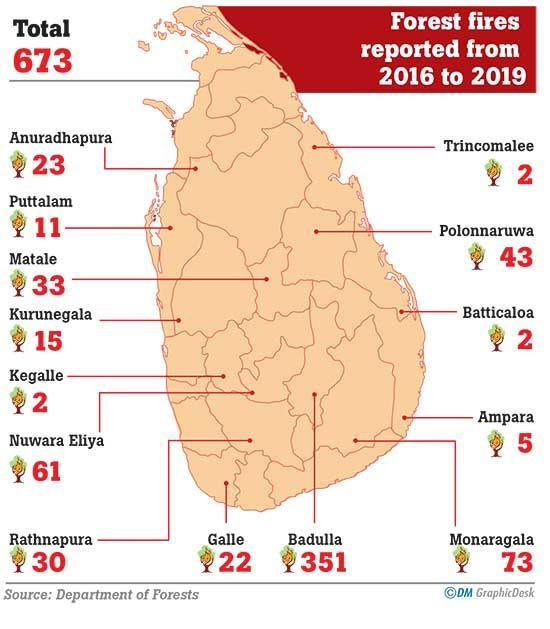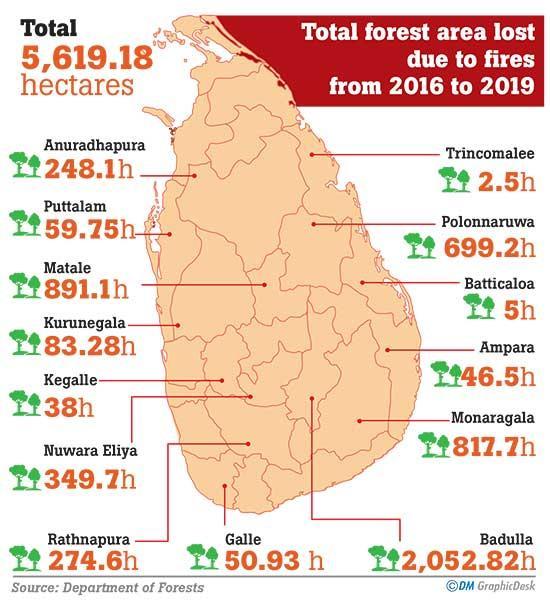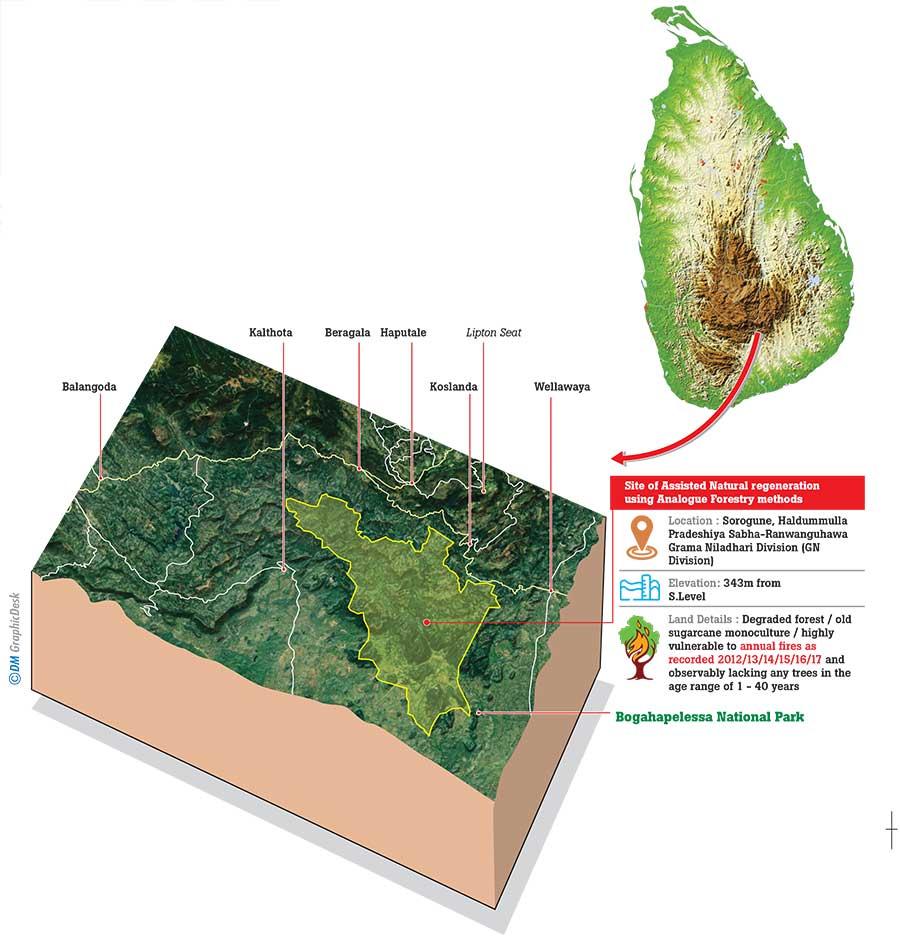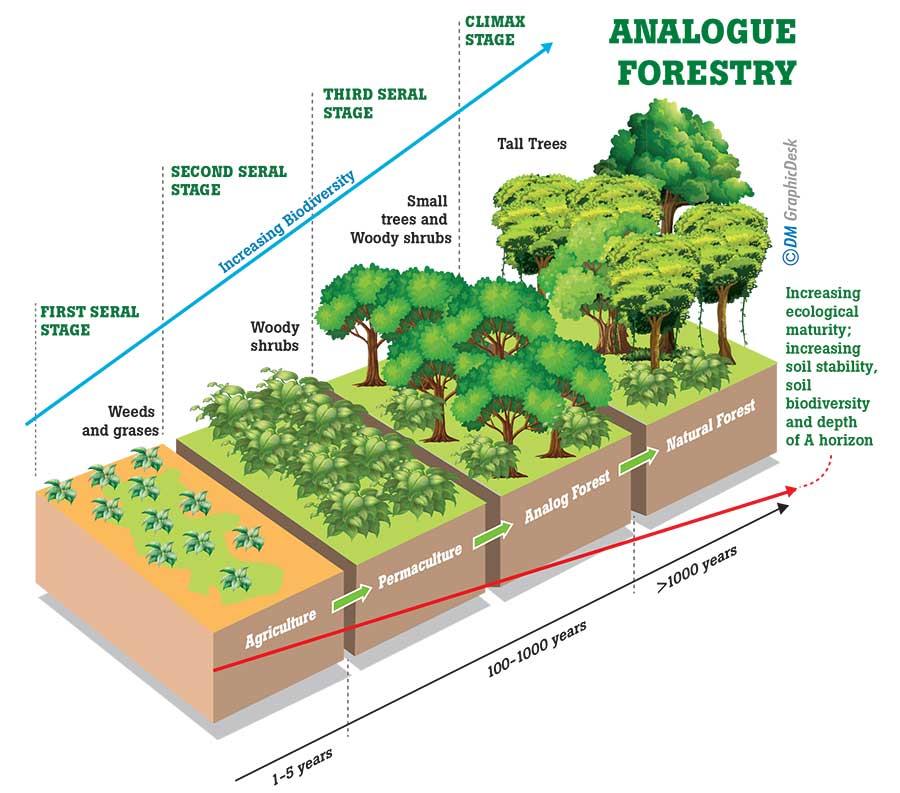30 Jan 2020 - {{hitsCtrl.values.hits}}

Eye reports from Beragala

Forest destruction due to fires has become a serious problem in some regions in Sri Lanka, especially in areas like Beragala, Haputale of the Badulla District. Throughout the years fires continue to rage, with more land area burnt and destroyed each year. Yet, there is no methodical way to prevent them.
Sri Lanka experiences nearly 50 to 200 cases of forest fires every year. According to the Disaster Management Center, man-made forest fires have increased by one hundred per cent.
During our investigation, we found that crucial forest fire management elements in Sri Lanka, such as coordination among Ministries, the contribution of the public, research and fire management are regrettably lacking in Sri Lanka.
Thus, there is a critical need to study the current situation of forest fire occurrences in the Sri Lankan context, along with examining the drawbacks with the procedure of forest fire controlling process in Sri Lankan context and effective solutions to address these man-made disasters.

All the previous disasters occurred at the height of the dry seasons when there is no rain for months. But there is also the global, human-induced climate change which increases the risk of forest fires.
Team Eye visited Beragala, Haputale to meet Dr Ranil Senanayake, a renowned ecologist and the originator of the analogue forestry concept, who has not only been fighting against forest fires but also taking effective action to restore forests and ecosystems destroyed by wildfires.
Forest fires are caused by natural causes as well as man-made causes. Some forest fires start from natural causes such as lightning, which set trees on fire. However, rain extinguishes such fires without causing much damage.
When it comes to Sri Lanka, almost all forest fire incidents are considered to be man-made.
Clause 6 of the Fauna and Flora Protection Ordinance prohibits burning, kindling, or carrying fire in strict natural reserves, national parks, nature reserves, and jungle corridors. If one does not abide by the Ordinance, he/she will be liable to a fine, imprisonment that could extend for six months, or both.
“They wait until the summer season every year. They set fire to the areas of the forests for wild meat or to encroach lands belong to the Forest Department for their cultivations. People get never arrested for these kinds of things.
Even if they get arrested, many pay off the Police to escape legal action,” a villager from Haputale under the condition of anonymity claimed. Soliciting and accepting bribes is not new to Sri Lanka. According to Global Corruption Barometer 2015, a third of Sri Lankans believe the Police are corrupt.
Villagers and environmentalists are alleging that some Police Officers are flouting the Police Code of Conduct to secure convictions of suspects in forest destruction cases with the blessings of local politicians. While governments have claimed to take anti-corruption attitudes, enforcement remains stagnant for decades.
"Forest is considered as a major natural resource and they play an important role in maintaining environmental balance. The health of the forest in an area indicates ecological conditions of that particular area. The fires not only burn down so many valuable trees but also cause a colossal loss of vegetation cover of that region"
Forest is considered as a major natural resource and they play an important role in maintaining environmental balance. The health of the forest in an area indicates ecological conditions of that particular area. The fires not only burn down so many valuable trees but also cause a colossal loss of vegetation cover of that region. Following is the number of forest lands that have been destroyed in the last fouryears.
Dr. Ranil Senanayake said while the unmitigated fires cause immense damage to flora and fauna in the short-term, it has various long-term consequences as well. “They pose a threat to the biodiversity, the ecology and biomass of a region which has been built up for centuries in the earth. Although media and the responsible authorities don’t seem to have taken this serious, the consequences of the forest fires will be far worse in future,” Dr Senanayake further said. As Dr Senanayake explained, forest fire causes imbalances in nature and endangers biodiversity by reducing faunal and floral wealth.
Traditional methods of fire prevention are not proving effective and it is now essential to raise public awareness on the matter, particularly among those people who live close to or in forested areas.
Fires are a major cause of forest degradation and have wide-ranging adverse ecological, economic and social impacts, including loss of valuable timber resources, biodiversity and extinction of plants and animals, wildlife habitats, natural regeneration and reduction in forest cover and carbon sink resources, which ultimately create a change in the climate of the area with unhealthy living conditions.
He also spoke about how this invariably leads to the drying up of the water tables in areas. “It also increases the heat, as there is no forest cover. There are so many water bodies connected to the streams running through Badulla district. Fires can cause contamination of water in the natural resources and results in a lack of drinking water.
These are not imaginations, but the truth that others ignore to see and take action for,” Dr Senanayake stressed.
We, as a country Sri Lanka are not well-equipped to fight or prevent wildfires. The major cause of the continuous cycle of forest fires through which more areas are burnt each year is the disorganized approach to the problem.
The national focus is the country has been limited to politically induced incidents and real threats to the citizens of Sri Lanka are heavily ignored.
Dr Senanayake emphasised how important it is to have a mechanism through which public awareness and community participation in protecting the environment can be
done systematically.
"Some forest fires start from natural causes such as lightning, which set trees on fire. However, rain extinguishes such fires without causing much damage"
As there is a set of practical technical ways to address this issue, as Dr Senanayke said the situation can be changed in just two decisions by a responsible politician. “Vigorous follow up action is missing in this country,” he said.
All forest fires in Sri Lanka can be directly attributable to human behaviour. This means the power to control forest fires and even to prevent them from developing into mega-fires is in our own hands. Taking into consideration the very serious nature of the problem, it is high time to make some major improvements in the forest fire management strategy for the country.



Restoration is not necessarily about planting more trees. It is a low-cost technical method, which can be used to effectively regenerate our forests and decrease carbon levels, simply put, it is a way to assist nature to do its job.
Dr. Ranil Senanayake is the creator of the science and art of analogue forestry. During the Daily Mirror’s visit to Belipola Arboretum, the world’s first-ever analogue forest, Dr Senanayake shared some alarming facts which concerns the future of forest restoration in Sri Lanka.
In places where forests have been degraded and are non-productive, restoration or reforestation projects have to be undertaken to assure or accelerate the recovery of forests. According to Dr Senanayake, the objectives of forest restoration can range from economic incentives, social and cultural values, ecosystem services, and a whole new level of biodiversity conservation.
"Forest restoration is not a new concept to Sri Lanka. Sharing some historical facts on reforestation projects, Dr Senanayake pointed out that the quality landscape in the Belipola Arboretum has been silently developing over the past three decades and currently, it is creating a valuable ecosystem within the Central hills"
“This year will be a critical one for the prevention of fires in Sri Lanka. So we have to especially focus on restoring the forests. The task of forest restoration can be a complex one but with the effects of climate change Sri Lankans have to think about ways of restoring forests,” Dr Senanayake explained.
 In the broad sense of the term, forest restoration is not a new concept to Sri Lanka.
In the broad sense of the term, forest restoration is not a new concept to Sri Lanka.
Sharing some historical facts on reforestation projects, Dr Senanayake pointed out that the quality landscape in the Belipola Arboretum has been silently developing over the past three decades and currently, it is creating a valuable ecosystem within the Central hills.
During a visit to upcountry areas in Sri Lanka, we are always presented with a panoramic view of two different systems of land management. Sri Lanka is a country with a history where many monoculture varieties of plants, such as tea and rubber are flourishing for over 50 years. Dr. Senanayake highlighted that with this historical change, the soil of the Central hills change rapidly in a wrong ecological manner where it develops more carbon in the soil.
“When changes in the human arrangement and livelihood practices result in agricultural fields being abandoned, those changes can naturally restore as forests. But in Sri Lankan monoculture cultivation we have to think again that how to develop our soil with quality biomass,” Dr Senanayake said.
In 1981, Dr Senanayake initiated a biodiversity revolution at a 17 acre land in Belipola, which is currently home to an ecological laboratory where many students and researchers visit to study the development of forest restoration. Dr Senanayake said that he has been struggling for many years issuing warnings on possible environmental impacts which can occur due to the policies of the forest and agricultural departments.
“Tea is one of the main income-generating crops on the island but we have to admit that it has contributed to a large scale of deforestation in the country. We have to research growing tea organically and to promote the ‘foresting method’ in the lands where we grow these monoculture plants. That will assist nature to decrease carbon levels through multiple plant species,” Dr. Senanayake opined.

"In places where forests have been degraded and are non-productive, restoration or reforestation projects have to be undertaken to assure or accelerate the recovery of forests"
The ecologist said that monocultures cannot be considered as forests and that modern forestry on the whole island is developing chaotically.
“We have so many government authorities concerning forest conservation and disaster mitigation. Yet no single agency has looked into this matter where in the near future, due to rising temperatures and the heat, these monoculture cultivation systems are vulnerable to raging fires, which have the potential to set ablaze the Central Hills. This is going to be a massive disaster in the country,” Dr Senanayake warned during our field visit.
He said that climate change is no longer a futuristic phenomenon and that people must change their way
of thinking. “We are not a planet ‘Sri Lanka’, we are also part of planet Earth and the authorized officials should formulate a plan to move ahead with the climate change happening in the country” he stressed.
The concept of analogue forestry was developed as a true modern perception by Dr Ranil Senanayake and his team who are currently focused on their work with the Earth Restoration group.
During the visit to Belipola Arboretum, the Daily Mirror team witnessed a group of young people who were involved in forest restoration by following the footprints of Dr. Senanayake.
A core member of this conservation group and CEO of the Earth Restoration Private Limited Dejan de Zoysa now owns land in an upcountry village called Bogahapelessa, where he is developing another
restoration patch.
According to his view, traditional forest conservation and modern pollution are chocking in the stability of primary ecosystem services and causing them to go extinct.
"We have so many government authorities concerning forest conservation and disaster mitigation. Yet no single agency has looked into this matter where in the near future, due to rising temperatures and the heat, these monoculture cultivation systems are vulnerable to raging fires, which have the potential to set ablaze the Central Hills"
As a solution for this above-mentioned matter, Dr Senanayake, including de Zoysa and team members, had developed the concept ‘Analogue Forestry’ to protect and develop the primary ecosystem in the country.
“What we do in analogue forestry is learning to observe a forest. Forests can be very overwhelming and if we know a structured format of how to observe the forest it becomes communication and there is a process to it,” Dejan de Zoysa explained in his presentation on analogue forestry.
In brief, the method of analogue forestry consists of selecting varieties of native and economically valuable forest species which are at the same time analogous or similar.
According to Dr Senanayake and Dejan de Zoysa by following this way, the land serves to support biodiversity and maximize ecosystem services.
At the same time, it can also boost rural livelihoods as well as guarantee food security. According to these experts having a variety of plants in one land can increase the oxygen level and clean water cycling throughout the whole ecosystem.
"Analogue Forestry is a complex and holistic form of silviculture, which minimizes external inputs, such as agrochemicals and fossil fuels, instead of fostering ecological function for resilience and productivity"
De Zoysa also said that by observing the forest and observing its functionality the people can increase the given content of biomass and biodiversity. “Some key principles we can highlight is to start by thinking about the structure,” he said.
An analogue forest system is a structural and functional method which can be developed within a primary ecosystem,” Dejan de Zoysa highlighted.
Referring to the principles of analogue forestry he said that as the first step the lay of the land extending to watercourses, slopes and microclimates, have to be understood. He also said that to start analogue forestry as a practice, one has to identify levels of yield; that can be restored as an ecosystem. This in turn, if managed properly can increase the biodiversity, ecosystem services and economic production.
Analogue Forestry is an approach to ecological restoration which uses natural forests as guides to create ecologically stable and socio-economically productive landscapes. Analogue Forestry is a complex and holistic form of silviculture, which minimizes external inputs, such as agrochemicals and fossil fuels, instead of fostering ecological function for resilience and productivity.
Analogue Forestry values not only ecological sustainability but also recognises local rural communities’ social and economic needs, which can be met through the production of a diversity of useful and marketable goods and services, ranging from food to pharmaceuticals and fuel to fodder.

| Eye is Dailymirror ’s segment to engage with the public through investigative journalism in order to spark action. If you have any issues which deserve to be told in the Eye and which would otherwise go unreported, write to us [email protected] or Deputy Editor - Investigations, Dailymirror, Wijeya Newspapers, No. 8, Hunupitiya Cross Road, Colombo 02, Sri Lanka. |
07 Jan 2025 6 hours ago
07 Jan 2025 7 hours ago
07 Jan 2025 8 hours ago
07 Jan 2025 07 Jan 2025
07 Jan 2025 07 Jan 2025